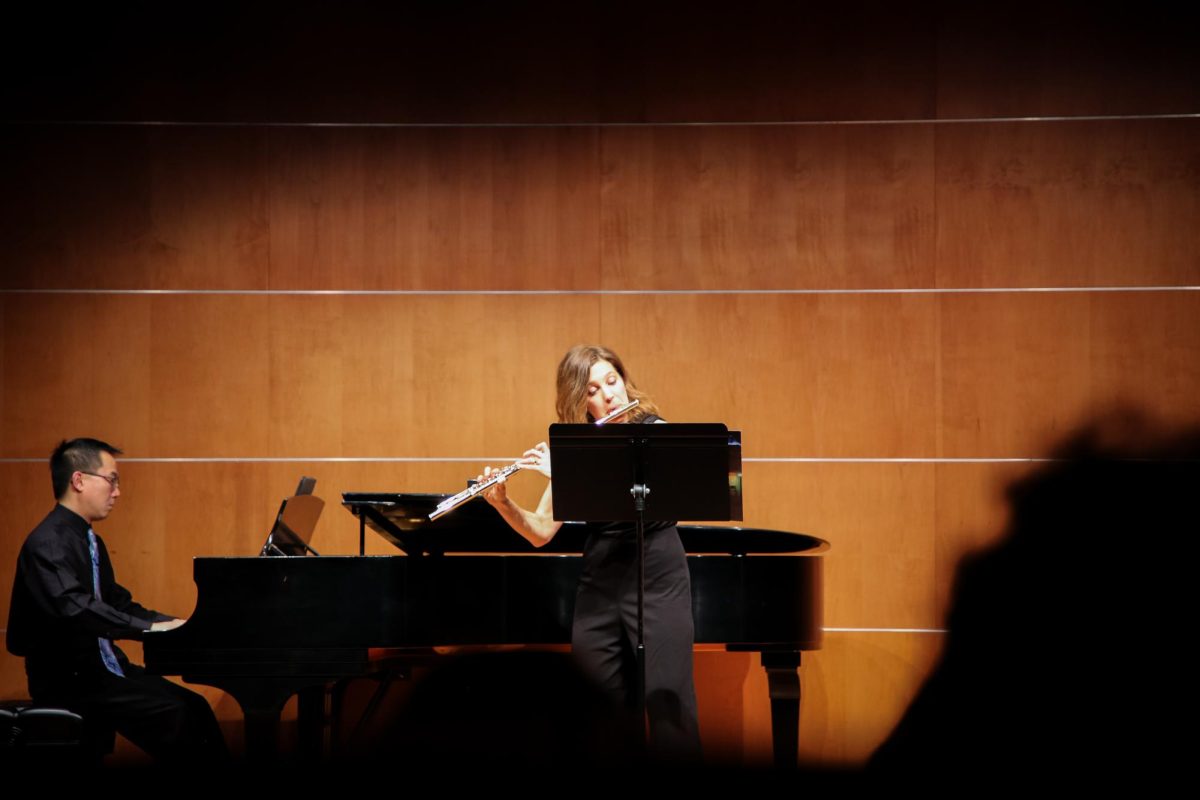On Feb. 8, Grand Valley State University hosted Abigail Walsh, DMA, Visiting Professor of Flute at GVSU, in the Sherman van Solkema Recital Hall for a program titled “Echoes of Time.” Walsh was accompanied by award-winning pianist Sidney Yin, DMA, with production overseen by Bill Ryan, DMA, Professor of Composition and Director of GVSU’s New Music Ensemble.
The event allowed people to listen to live music based on innovative concepts present in both production and performance.
Walsh is an accomplished flutist and educator, with performing credits in the Illinois Symphony Orchestra, West Michigan Symphony, Holland Symphony, the Great Lakes Chamber Orchestra and the Flute New Music Consortium. Currently, Walsh serves as the co-lead of GVSU’s Community Engagement Music Project (CEMP) and is the vice president of the West Michigan Flute Association.
Yin previously taught at the Juilliard School, the Peabody Conservatory of the Johns Hopkins University and Loyola University Chicago. He has performed with the Burnaby Symphony, Vancouver Symphony Orchestra, New Juilliard Ensemble, Northeastern Pennsylvania Philharmonic and the San Diego Symphony. Additionally, Yin was a guest pianist for Yo-Yo Ma’s Silkroad organization.
With an emphasis placed on time, the performers explored the relationship between past and present music. Both pieces in the set were written by living composers, blending classical structure with contemporary perspectives and modern technologies.
“It’s very fun to see how people take the traditions of the past and reinvent them in different ways for music (that), for now, represent different things, different emotions and different events that are happening in the world,” Walsh said.
The incorporation of the piano and flute was another important aspect of the performance. Yin said the combination of the two instruments lends itself to a very particular sound that requires the two performers to constantly listen to each other, with adjustments made accordingly.
“One is a very sharp instrument, and the other is a percussive string instrument,” Yin said. “In order to make it work together, you really have to listen to each other and adjust. Walsh can change her embouchure to bend the pitch and match the piano, but with the pianist, it’s often how you support them. You support the flute player when you need to, and then back off when you need to as well.”
The piece many audiences connected with was “Rapids,” written by Christian Glascock, a flutist at GVSU and a student of Walsh. In the piece, the sound from Walsh’s flute was sent through a computer plug-in, causing a delay that allowed Walsh to play two eighth notes behind herself. While the piece utilized modern technology, it was rooted in something “intrinsic” that can be heard in “Rapids’” echoes. Walsh said she credits Glascock with his help in pioneering this sound.
“All of the delay studies are based on something that happens in nature,” Walsh said. “This is a new genre of music that has been created by Glascock.”
Glascock has performed with GVSU’s Wind Symphony, Orchestra and New Music Ensemble, while also exploring new frontiers in his own compositions. In his progressive approach to contemporary composition, Glascock said he is inspired by time and often likes to experiment with and incorporate electronic sounds into his music.
“My first ever album was all about time. The whole idea really interested me,” Glascock said. “One day I was sitting at my computer messing around with different plug-ins and I found a delay. I was playing with it (a plug-in) and I was like, ‘this is crazy because it’s kind of warping time while also building this (electronic) texture.’ You’re building this huge thing all because time is shifted just a little bit.”
Glascock’s composition of “Rapids” is featured in “Plugged In: Practice and Performance Method for Flutists,” a book he and Walsh recently collaborated on.









